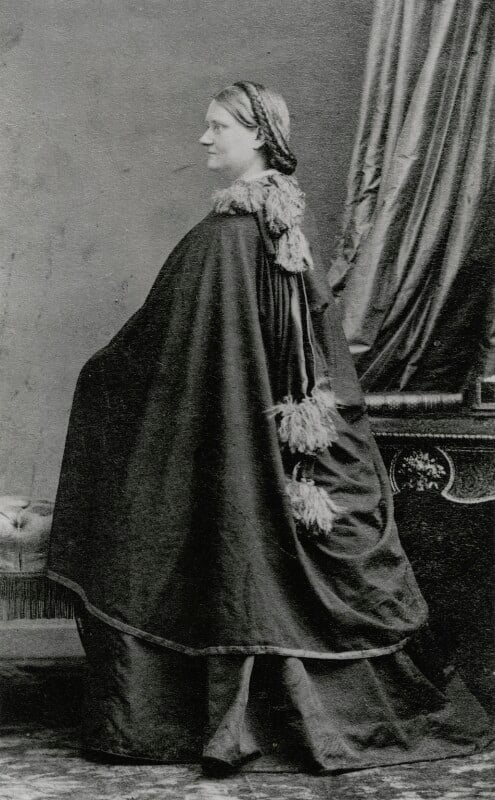
Barbara Leigh Smith Bodichon, 1827-1891, courtesy
of the National Portrait Gallery, London
Barbara Leigh Smith, the illegitimate daughter of Benjamin Leigh Smith, a Radical MP for Norwich, and Anne Longden, a milliner from Alfreton, Derbyshire, was born on 8 April 1827 near Robertsbridge, Sussex. Although her father was a member of the landed gentry, he held radical views and was a Dissenter, a Unitarian, a supporter of Free Trade, and was a benefactor to the poor. This family background, together with gender bias, made Barbara somewhat of an outsider throughout her life despite being born into wealth. The family left to live in the United States in July 1830 and lived there for almost two years before returning to England. Her mother died of tuberculosis in 1834 at Ryde on the Isle of Wight when Barbara was only seven years old. After the death of her mother, she was brought up by her father, first at Pelham Crescent, Hastings, and then later at 5 Blandford Square, Marylebone, in London.
Her father was an advocate of women's rights and treated Barbara in the same way as her brothers. She was educated at a Unitarian secondary school in Upper Clapton in London from 1838-1841. All of the Smith children had drawing lessons and Barbara may have participated in the art classes offered by Eliza Fox held in the library of her father's home. Barbara is also known to have had instruction from William Henry Hunt, Cornelius Varley, David Cox, and W. Collingwood Smith. In 1845 Barbara met Anna Mary Howitt, who was training to become an artist at Sass's art school in London, and who was acquainted with many of the artists who would later form the Pre-Raphaelite Brotherhood.
In 1849 Barbara enrolled to study drawing at Bedford College, the new Ladies' College in Bedford Square, Bloomsbury, in London. Her instructor was Francis Cary who had previously taught her friend Anna Mary Howitt at Sass's Academy. From April 1848, when Barbara became twenty-one, she became financially independent, an almost unique position for a young unmarried woman. Her father gave her a portfolio of stocks and shares which yielded between £250 to £300 a year depending on the stock market.
Barbara was introduced to many members of the Pre-Raphaelite circle including D. G. Rossetti, Elizabeth Siddal, William Holman Hunt, William Bell Scott, William Stillman, and William Allingham. In 1850 she was a founding member of "The Portfolio Society" which met to exhibit their sketches and read their poetry. Members included Bessie Rayner Parkes, Anna Mary Howitt, and Christina Rossetti. In 1850 Barbara went on painting expeditions to the Lake District and Wales and had two of her Welsh landscapes accepted by the Royal Academy. She later exhibited at the Society of British Artists, the British Institution, the Dudley Gallery, the Society of Female Artists, the French Gallery, and provincial galleries in Glasgow, Liverpool, and Birmingham. In 1850 Barbara travelled unchaperoned to Munich with her friend Bessie Parkes to visit their friend Anna Mary Howitt who was studying art under Wilhelm von Kaulbach at the Munich Academy of Fine Arts. In addition to Germany the pair also visited Belgium, Austria, and Switzerland. In 1854 Barbara was asked to join a sketching group called The Folio, which included many members of the Pre-Raphaelite circle.
Barbara was known for her feminist views, reformist causes, and her philanthropy. In the 1850s she and a group of like-minded friends began to meet in Langham Place in London to discuss women's rights. "The Langham Place Group" was one of the first organised women's movements in Britain. In 1854 Barbara published her Brief Summary of the Laws of England concerning Women that eventually helped lead to the passage of the Married Women's Property Act of 1882. In 1854 she also established the experimental Portman Hall School that was undenominational and co-educational. It was intended for children of different class backgrounds and welcomed children of various nationalities.
In 1857-58 a number of her landscapes were included in the Exhibition of Modern British Art that toured the United States. In 1857 she married Eugene Bodichon, a French doctor and social reformer with radical political views living in Algiers. The couple married at the Unitarian Chapel, Little Portland Street, in London. They spent many years wintering in Algiers, with both of them or Barbara alone staying in England during the summers. In 1858 she founded the feminist Englishwoman's Journal with her friend Bessie Raynor Parkes. In 1859 she had a single-artist exhibition at Ernest Gambart's French Gallery. In 1864 she spent time in Paris studying under Camille Corot. In 1866 she joined with Emily Davis to raise funds for the first women's college in Cambridge and Girton College was opened in 1873. In 1877 she suffered a debilitating stroke from which she never fully recovered. She was left an invalid, partially paralyzed, until her death at Robertsbridge, Sussex, near Hastings on June 11, 1891. She was buried in St Thomas a Becket churchyard in Brightling, East Sussex.
Link to Related Material
Bibliography
Burton, Hester. Barbara Bodichon 1827-1891. London: John Murray, 1949.
Frederick, Margaretta. "Politics and Paint: The Life Work of Barbara Leigh Smith Bodichon." Pre-Raphaelite Sisters. Art, Poetry and Female Agency in Victorian Britain. Edited by Glenda Youde and Robert Wilkes. Oxford: Peter Lang, 2022. 122-123.
Hirsch, Pam. Barbara Leigh Smith Bodichon: Feminist, Artist and Radical. London: Chatto & Windus, 1998.
Robinson, Jane. Trailblazer: Barbara Leigh Smith Bodichon: The First Feminist to Change Our World. London: Doubleday, 2024.
Created 1 February 2025